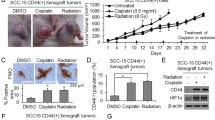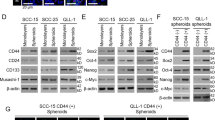Abstract
Cancer stem cells (CSCs) have been suggested as responsible for the initiation and progression of cancers. Octamer-binding transcription factor 4 (Oct4) is an important regulator of embryonic stem cell fate. Here, we investigated whether Oct4 regulates stemness of head and neck squamous carcinoma (HNSC) CSCs. Our study showed that ectopic expression of Oct4 promotes tumor growth through cyclin E activation, increases chemoresistance through ABCC6 expression and enhances tumor invasion through slug expression. Also, Oct4 dedifferentiates differentiated HNSC cells to CSC-like cells. Furthermore, Oct4high HNSC CSCs have more stem cell-like traits compared with Oct4low cells, such as self-renewal, stem cell markers' expression, chemoresistance, invasion capacity and xenograft tumorigeneity in vitro and in vivo. In addition, knockdown of Oct4 led to markedly lower HNSC CSC stemness. Finally, there was a significant correlation between Oct4 expression and survival of 119 HNSC patients. Collectively, these data suggest that Oct4 may be a critical regulator of HNSC CSCs and its targeting may be potentially valuable in the treatment of HNSC CSCs.
This is a preview of subscription content, access via your institution
Access options
Subscribe to this journal
Receive 50 print issues and online access
$259.00 per year
only $5.18 per issue
Buy this article
- Purchase on Springer Link
- Instant access to full article PDF
Prices may be subject to local taxes which are calculated during checkout







Similar content being viewed by others
References
Jemal A, Murray T, Samuels A, Ghafoor A, Ward E, Thun MJ . Cancer statistics, 2003. CA Cancer J Clin 2003; 53: 5–26.
Forastiere A, Koch W, Trotti A, Sidransky D . Head and neck cancer. N Engl J Med 2001; 345: 1890–1900.
Yamano Y, Uzawa K, Saito K, Nakashima D, Kasamatsu A, Koike H et al. Identification of cisplatin-resistance related genes in head and neck squamous cell carcinoma. Int J Cancer 2010; 126: 437–449.
Lim YC, Oh SY, Cha YY, Kim SH, Jin X, Kim H . Cancer stem cell traits in squamospheres derived from primary head and neck squamous cell carcinomas. Oral Oncol 2011; 47: 83–91.
Yang MH, Hsu DS, Wang HW, Wang HJ, Lan HY, Yang WH et al. Bmi1 is essential in Twist1-induced epithelial–mesenchymal transition. Nat Cell Biol 2010; 12: 982–992.
Wang XQ, Ongkeko WM, Chen L, Yang ZF, Chen KK, Lopez JP et al. Octamer 4 (Oct4) mediates chemotherapeutic drug resistance in liver cancer cells through a potential Oct4-AKT-ATP-binding cassette G2 pathway. Hepatology 2010; 52: 528–539.
Chang CC, Shieh GS, Wu P, Lin CC, Shiau AL, Wu CL . Oct-3/4 expression reflects tumor progression and regulates motility of bladder cancer cells. Cancer Res 2008; 68: 6281–6291.
Scholer H, Ruppert S . New type of POU domain in germ line-specific protein Oct4. Nature 1990; 344: 435–439.
Nichols J, Zevnik B . Formation of pluripotent stem cells in the mammalian embryo depends. Cell 1998; 95: 379–391.
Chiou SH, Yu CC, Huang CY, Lin SC, Liu CJ, Tsai TH et al. Positive correlations of Oct-4 and Nanog in oral cancer stem-like cells and high-grade oral squamous cell carcinoma). Clin Cancer Res 2008; 14: 4085–4095.
Ge N, Lin HX, Xiao XS, Guo L, Xu HM, Wang X et al. Prognotic significance of Oct4 and Sox2 expression in hypopharyngeal squamous cell carcinoma. J Transl Med 2010; 8: 94.
Tsai LL, Yu CC, Chang YC, Yu CH, Chou MY . Markedly increased Oct4 and Nanog expression correlates with cisplatin resistance in oral squamous cell carcinoma. J Oral Pathol Med 2011; 40: 621–628.
Jordan CT, Guzman ML, Noble M . Cancer stem cells. N Engl J Med 2006; 355: 1253–1261.
Joo KM, Kim SY, Jin X, Song SY, Kong DS, Lee JI et al. Clinical and biological implications of CD133-positive and CD133-negative cells in glioblastomas. Lab Invest 2008; 88: 808–815.
Wiegand S, Dunne AA, Muller HH, Mandic R, Barth P, Davis RK et al. Metaanalysis of the significance of matrix metalloproteinases for lymph node disease in patients with head and neck squamous cell carcinoma. Cancer 2005; 104: 94–100.
Mani SA, Guo W, Liao MJ, Eaton EN, Ayyanan A, Zhou AY et al. The epithelial–mesenchymal transition generates cells with properties of stem cells. Cell 2008; 133: 704–715.
Yu F, Sim AC, Li C, Li Y, Zhao X, Wang DY, Loh KS . Identification of a subpopulation of nasopharyngeal carcinoma cells with cancer stem-like cell properties by high aldehyde dehydrogenase activity. Laryngoscope 2013; 123: 1903–1911.
Dalerba P, Dylla SJ, Park IK, Liu R, Wang X, Cho RW et al. Phenotypic characterization of human colorectal cancer stem cells. Proc Natl Acad Sci USA 2007; 104: 10158–10163.
Lengner CJ, Welstead GG, Jaenisch R . The pluripotency regulator Oct4: a role in somatic stem cells? Cell Cycle 2008; 7: 725–728.
Looijenga LH, Stoop H, de Leeuw HP, de Gouveia Brazao CA, Gillis AJ, van Roozendaal KE et al. POU5F1 (OCT3/4) identifies cells with pluripotent potential in human germ cell tumors. Cancer Res 2003; 63: 2244–2250.
Jung JW, Park SB, Lee SJ . Metformin represses self-renewal of the human breast carcinoma stem cells. PLoS One 2011; 6: e28068.
Steg AD, Bevis KS, Katre AA, Ziebarth A, Dobbin ZC, Alvarez RD et al. Stem cell pathways contribute to clinical chemoresistance in ovarian cancer. Clin Cancer Res 2012; 18: 869–881.
Chen KG, Sikic BI . Molecular pathways: regulation and therapeutic implications of multidrug resistance. Clin Cancer Res 2012; 18: 1863–1869.
Takahashi K, Yamanaka S . Induction of pluripotent stem cells from mouse embryonic and adult fibroblast cultures by defined factors. Cell 2006; 126: 663–676.
Kumar SM, Liu S, Lu H, Zhang H, Zhang PJ, Gimotty PA et al. Acquired cancer stem cell phenotypes through Oct4-mediated dedifferentiation. Oncogene 2012; 31: 4898–4911.
Gerrard L, Zhao D, Clark AJ, Cui W . Stably transfected human embryonic stem cell clones express OCT4-specific green fluorescent protein and maintain self-renewal and pluripotency. Stem Cells 2005; 23: 124–133.
Xie LQ, Bian LJ, Li Z, Li Y, Li ZX, Li B . Altered expression of E-cadherin by hepatocyte growth factor and effect on the prognosis of nasopharyngeal carcinoma. Ann Surg Oncol 2010; 17: 1927–1936.
Acknowledgements
This work was supported by a grant of the Korean Health Technology R&D Project, Ministry of Health and Welfare, Republic of Korea (Grant number A111700 to YCL) and by the National Research Foundation of Korea (NRF) grant funded by the Korea government (MEST) (Grant number 2012R1A2A2A01046214 to YCL and 2013R1A2A2A01015281 to BSK).
Author information
Authors and Affiliations
Corresponding author
Ethics declarations
Competing interests
The authors declare no conflict of interest.
Additional information
Supplementary Information accompanies this paper on the Oncogene website
Supplementary information
Rights and permissions
About this article
Cite this article
Koo, B., Lee, S., Kim, J. et al. Oct4 is a critical regulator of stemness in head and neck squamous carcinoma cells. Oncogene 34, 2317–2324 (2015). https://doi.org/10.1038/onc.2014.174
Received:
Revised:
Accepted:
Published:
Issue Date:
DOI: https://doi.org/10.1038/onc.2014.174
This article is cited by
-
Restricting epigenetic activity promotes the reprogramming of transformed cells to pluripotency in a line-specific manner
Cell Death Discovery (2023)
-
Clinical Significance of Overexpression of Oct4 in Advanced Stage Gallbladder Carcinoma
Journal of Gastrointestinal Cancer (2023)
-
Prognostic and predictive roles of cancer stem cell markers in head and neck squamous cell carcinoma patients receiving chemoradiotherapy with or without nimotuzumab
British Journal of Cancer (2022)
-
Resistance to tyrosine kinase inhibitors promotes renal cancer progression through MCPIP1 tumor-suppressor downregulation and c-Met activation
Cell Death & Disease (2022)
-
OCT4-mediated transcription confers oncogenic advantage for a subset of gastric tumors with poor clinical outcome
Functional & Integrative Genomics (2022)



